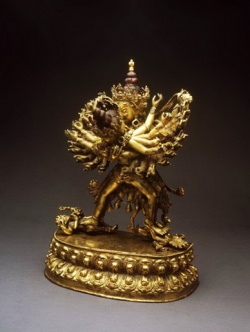Difference between revisions of "The Kalachakra Laghutantra"
| Line 1: | Line 1: | ||
[[File:L_pl1g19.jpg|thumb|250px|]] | [[File:L_pl1g19.jpg|thumb|250px|]] | ||
| − | The [[Kalachakra Tantra]] is divided into five chapters, the first two of which are considered the “ground [[Kalachakra]].” The first chapter deals with what is called the “outer [[Kalachakra]]”—the [[physical]] [[world]], in particular the calculation system for the [[Kalachakra]] [[calendar]]. It also explicates the basic [[symbolism]] of the [[Kalachakra]] system The second chapter deals with the “inner [[Kalachakra]],” and concerns {{Wiki|processes}} of [[human]] gestation and [[birth]], the {{Wiki|classification}} of the functions within the [[human body]] and [[experience]], and the vajra- | + | The [[Kalachakra Tantra]] is divided into five chapters, the first two of which are considered the “ground [[Kalachakra]].” The first chapter deals with what is called the “outer [[Kalachakra]]”—the [[physical]] [[world]], in particular the calculation system for the [[Kalachakra]] [[calendar]]. It also explicates the basic [[symbolism]] of the [[Kalachakra]] system The second chapter deals with the “inner [[Kalachakra]],” and concerns {{Wiki|processes}} of [[human]] gestation and [[birth]], the {{Wiki|classification}} of the functions within the [[human body]] and [[experience]], and the [[vajra-kaya]]—the expression of [[human]] [[physical]] [[existence]] in terms of [[channels]], [[winds]], [[drops]] and so forth. [[Human]] [[experience]] is described as consisting of four [[mind states]]: waking, [[dream]], deep [[sleep]], and a fourth state, the [[experience]] of {{Wiki|sexual}} orgasm. The potentials (drops) which give rise to these states are described, together with the {{Wiki|processes}} that flow from them. |
The last three chapters describe the “other [[Kalachakra]],” and deal with the [[path]] and [[fruition]]. The third chapter deals with the preparation for the [[meditation practices]] of the system, the [[initiations]] of [[Kalachakra]]. The fourth chapter explains the actual [[meditation practices]] themselves, both the [[meditation]] on the [[mandala]] and [[deity]] of [[Kalachakra]] in the generation process, and the [[perfection]] process of the [[Six Yogas]]. The fifth and final chapter describes the [[state of enlightenment]] that results from the practice. | The last three chapters describe the “other [[Kalachakra]],” and deal with the [[path]] and [[fruition]]. The third chapter deals with the preparation for the [[meditation practices]] of the system, the [[initiations]] of [[Kalachakra]]. The fourth chapter explains the actual [[meditation practices]] themselves, both the [[meditation]] on the [[mandala]] and [[deity]] of [[Kalachakra]] in the generation process, and the [[perfection]] process of the [[Six Yogas]]. The fifth and final chapter describes the [[state of enlightenment]] that results from the practice. | ||
Latest revision as of 12:14, 19 November 2013
The Kalachakra Tantra is divided into five chapters, the first two of which are considered the “ground Kalachakra.” The first chapter deals with what is called the “outer Kalachakra”—the physical world, in particular the calculation system for the Kalachakra calendar. It also explicates the basic symbolism of the Kalachakra system The second chapter deals with the “inner Kalachakra,” and concerns processes of human gestation and birth, the classification of the functions within the human body and experience, and the vajra-kaya—the expression of human physical existence in terms of channels, winds, drops and so forth. Human experience is described as consisting of four mind states: waking, dream, deep sleep, and a fourth state, the experience of sexual orgasm. The potentials (drops) which give rise to these states are described, together with the processes that flow from them.
The last three chapters describe the “other Kalachakra,” and deal with the path and fruition. The third chapter deals with the preparation for the meditation practices of the system, the initiations of Kalachakra. The fourth chapter explains the actual meditation practices themselves, both the meditation on the mandala and deity of Kalachakra in the generation process, and the perfection process of the Six Yogas. The fifth and final chapter describes the state of enlightenment that results from the practice.
